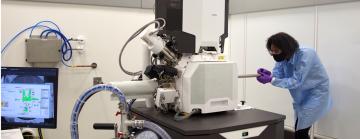Facilities and Resources
SCSC CryoET Facilities
Equipment*
CryoEM specimen preparation devices, cryo-fluorescence optical microscopes, cryo-focused ion beam scanning electron microscopes, and 200/300 kV electron cryo-microscopes equipped with direct electron detectors, energy filters, and phase plates. (see photos of available instruments). SCSC users will have access to these instruments after proper training.
- High Pressure and Plunge Freezing Instruments including Leica EM ICE, Leica GP, Thermo Fisher Vitrobot, and Gatan CP3 plunger in a low humidity laboratory.
- Cryo Fluorescent Light Microscopy (cryoFLM) includes an Airyscan LSM800 and Nikon Eclipse 80i both equipped with Linkam cryostages, also in a low humidity laboratory.
- Cryo Focused Ion Beam and Scanning Electron Microscopes (CryoFIB-SEM) including Thermo Fisher Aquilos 2 with Fluorescence Light Microscope.
- Cryo-Sectioning Ultramicrotome Leica UC6 equipped with a cryo chamber.
- CryoEM Titan Krios Galcios 2 electron microscopes are equipped with Volta phase plate, energy filter (BioQuantum or Selectris), and direct electron detector (K3 or Facon 4i camera).
*Full list of SCSC Instrumentation
Biological Laboratory Facilities:
SCSC has a tissue culture laboratory, cold room and refrigeration facilities, and standard biochemistry instrumentation available for onsite users. These facilities are BSL-2 compliant.
Data Management and Computational Resources:
All experimental data collected under SCSC will be held on disk for two months from the day of collection. The data is transferred to the data cluster as soon as it is collected and is therefore immediately available for download via either the usual Unix tools (RSYNC, SCP, BBCP, etc.) or through Globus. More details regarding data transfer can be found at https://confluence.slac.stanford.edu/x/mYoYDg.
After two months, the data is transferred onto tape and will be kept for 22 additional months. Requests for data retrieval after the data is moved onto tape can be made via email to unix-admin@slac.stanford.edu with specific information regarding the date of the data collection, the proposal number, and the microscope that was used.
Two years after the data has been collected, the data will be purged completely from our systems.

